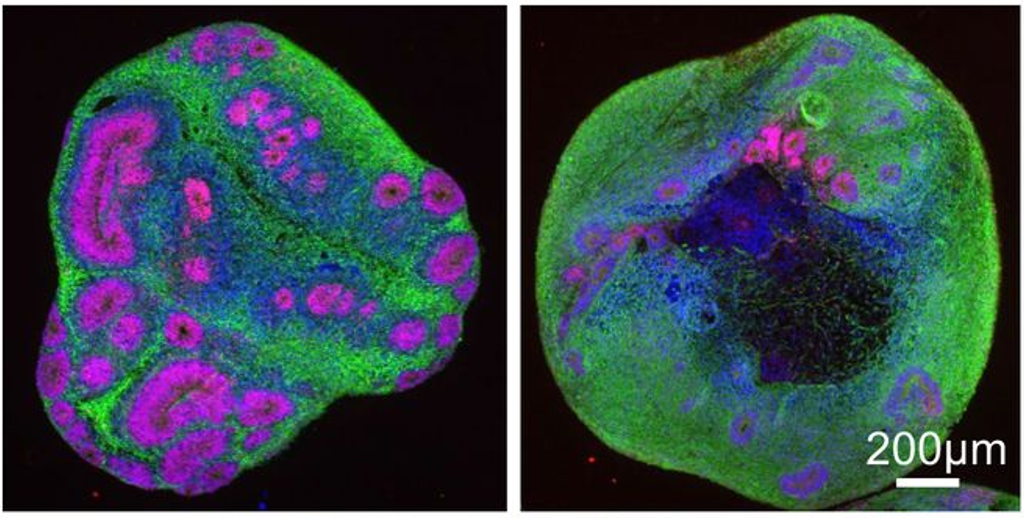
The third dimension: using minibrains to understand brain development changes in HD
Researchers show that highly expanded CAGs in the HD gene can cause early developmental changes using 3D brain models called organoids. What’d they find?

A new publication used tiny 3D brain models created from human cells to show that the mutation that causes HD could lead to early changes in brain development. However, it’s clear that HD patients can, and do, develop fully mature brain cells that maintain normal function, in most cases, for decades. So let’s put these findings into context and dig into what these developmental changes that have been discovered using human cells in a dish might mean for HD patients.
Getting human brain cells without collecting brain samples
Even though HD is unique to humans, most organisms have a version of the gene that is mutated to cause HD – huntingtin, or Htt for short. A variety of organisms can be used for studying HD and each model can inform different aspects of how the disease works. For example, if a scientist wants to know if an experimental treatment could benefit HD, they could use fruit flies or even worms to get those answers.

While flies and worms are quite different than humans, they have very short lifespans (about 14 days for fruit flies) so scientists can get their answers quickly. If they want to know what will happen in a more complex brain, scientists often choose mice. But to understand the effects that their work will have in humans, scientists need to test their ideas in humans – or at least human cells.
In 2006 two separate scientists showed that you can reverse the biological timeline of a skin cell, priming it to turn into any other cell type in the body. More recently, blood cells have even been used. These primed cells are called “induced pluripotent stem cells”, or iPSCs.
If scientists are interested in studying a brain disease like HD, they can then turn those iPSCs into the cell types of interest, like neurons. And even better, if the skin or blood cells are from an HD patient, scientists then have everything they need to study the neurons of that patient without having to take a brain sample. Not only super cool science, but also great news for HD patients, who would like to hang onto their brains!
Usually, cells are grown on the flat surface of a Petri dish, but recently researchers have devised a way to coax iPSCs to grow into 3 dimensional balls of cells – which resemble a little brain at an early stage of development. These 3D structures are called brain organoids and are akin to a tiny model of a brain.
Growing these cells in 3D allows researchers to study the way that they organize as the organoid grows, informing very early events in development within the brain. But while these tiny brain-like structures seem to have similar early developmental patterns to a human brain, it’s not a working replica and they don’t possess the capacity for cognitive function.
You are a beautiful and unique snowflake
“In a recent study, these brain organoids were used to investigate the impact that the mutation that causes HD has on their development. They did this using 4 different cell lines that are identical in every way, except one: the HTT gene.”
In a recent study, these brain organoids were used to investigate the impact that the mutation that causes HD has on their development. They did this using 4 different cell lines that are identical in every way, except one: the HD gene. But, wait. How can 4 different cell lines be identical and different?
You can think of people as snowflakes – we’re all unique in our own way, not just with obvious physical differences, like different hair color or eye shape, but also at the genetic level. Everyone has a slightly unique makeup in the code of their DNA that makes them different. So while 2 people may have the genetic code necessary for hands, one may have very long fingers and another may have short fingers.
If researchers take cells from 2 people, one with HD and one without, their cells will not only contain the different CAG lengths of that person’s HTT gene, but will also contain all the other genetic differences that make them uniquely them! This can confuse results a bit though because researchers won’t know if any changes they measure are because of differences in their HD gene or if they’re because of another unique alteration in that person’s DNA.
So back to those identically different cells – to prevent any confusion in their study about whether the results are from different CAG lengths in the HD gene or some other unique DNA code a person has, researchers used a series of cell lines originating from a single cell line that has been genetically altered only within the HTT gene so that it contains CAG repeats of different sizes.
In this case, the CAG repeat tract was increased from 30 (to represent someone without a risk for HD) to 45, 65, or 81 (representing adult-, adolescent-, or juvenile-onset HD, respectively) while all other genes in these cells remained identical. So now the researchers can be sure that any differences they observe between these cell lines are explicitly due to the changes they induced in the HD gene. Pretty clever!
Early-onset juvenile HD may not be a purely degenerative disorder

When using all 4 cell lines to create organoids, the first thing the researchers noticed was that even though organoids from all 4 lines were the same size, the HD organoids developed smaller internal structures that developmentally lead to the formation of important brain cells called neurons, suggesting that brain development is blunted. However, this was only observed in organoids that correspond to adolescent- (CAG of 65) and juvenile-onset HD (CAG of 81), while the organoids that represents adult-onset HD (CAG of 45) were similar to the organoids representing someone without HD.
So what does this mean? The authors interpreted their findings to mean that the mutation that causes HD, particularly in cases of juvenile-onset, stunts brain development. However, an alternative idea is that the mutation that causes HD may just delay development.
To test this, the authors examined older organoids – they measured the difference between the organoids that have 30 and 81 CAGs and found that they still had smaller internal structures, even at this later time point. So it appears that, at least for juvenile-onset HD cases, brain development in these organoids is not just delayed, but rather stalled. However, the adolescent- and adult-onset organoids weren’t included in this specific experiment.
Another key finding from this study suggests that the juvenile-onset organoids develop into neurons more quickly than the organoids without the HD mutation. But if you’ve been staying up-to-date on your HD organoid literature, you may find this a bit confusing because a paper that came out about a year ago found the exact opposite – that HD organoids derived from iPSCs develop into neurons more slowly than organoids without HD.
So does this mean that one study is right and the other is wrong? No. Even though the 2 studies found opposite effects in the speed of HD organoid neurodevelopment, each study was performed slightly differently, using different cell lines and measuring effects at different time points.
What both studies agree on is that the mutation that causes HD leads to early changes in neurodevelopment. But, just because results suggest early changes in development doesn’t mean that these changes can’t be compensated for. In fact, the authors of the more recent study identified a drug with the ability to partially restore the lower measurements they observed in the juvenile-onset HD organoids!
“What both studies agree on is that the mutation that causes HD leads to early changes in neurodevelopment. But, just because results suggest early changes in development doesn’t mean that these changes can’t be compensated for.”
But what about the organoids that represent adolescent- and adult-onset HD? If you’re a stickler for details, you may have noticed that most of the findings of this study just focus on organoids that represent juvenile-onset HD, which represent about 5-10% of the HD patient population. This means these experiments are assessing a rare form of an already rare disease. However, the authors of this study are diligent about interpreting their findings in the context of what their data represents, saying, “Overall, these findings suggest that HD, at least in its early-onset juvenile forms, may not be a purely neurodegenerative disorder and that abnormal neurodevelopment may be a component of its pathophysiology”.
Hot off the presses
One thing to note about this study is that it’s currently published in a repository called BioRxiv (pronounced “bio archive”). BioRxiv is a phenomenal resource because it publishes data ahead of print and is available to everyone. While this gets data out to the masses sooner, it also means that it hasn’t undergone the scientific process of “peer review”, which is an unbiased evaluation of the work by other scientists in the field who are unconnected to the project.
Peer review is critical for maintaining the rigor of scientific studies and provides the authors of the work a thoughtful outside perspective from other experts in their field. Because this study hasn’t yet undergone peer review, reviewers might request additional work prior to publication to clarify some of the results or even request further examination of the organoids that represent adolescent- and adult-onset HD. So you can think of this study like an unfinished book at the moment – we’ll have to tune back in after its final publication to get the full story.
Do these developmental changes ever normalize?
While the organoids are very cool because they can tell us about HD-related changes at the cellular level that occur early in development using human cells, we really need data from patients to interpret the effect that any changes may or may not have on a fully developed human.

Another study did just that and examined the sizes of different brain structures of children and adolescents (age 6 to 18) with and without the adult-onset form of the HD mutation using MRI. These are kids with no symptoms of HD, whose parents have agreed to allow them to participate in research to better understand the very earliest changes caused by the HD mutation.
This study reported a larger striatum (one of the primary brain regions affected by the mutation that causes HD) in HD mutation-carrying kids early on, from age 6 to 11, while HD gene-negative kids have a larger striatum later, from age 11 to 18. So it seems that the gene-positive kids have more rapid neurodevelopment, at least of the striatum, but that gene-negative kids eventually catch up and end up having a larger striatum at the ages examined in this study. However, this difference appears to be quite modest, with only about a 1mL swing – about ¼ of one gummy bear for perspective.
Studies like these that use non-invasive methods capable of detecting very small changes are exactly what’s needed to assess the contribution that HD has on brain development. They will help interpret findings from studies that represent very early development, such as the organoid study in a dish, in the context of human patients.
Ultimately, research demonstrating brain developmental changes resulting from HD is new, and while biologically interesting, researchers don’t yet know what it all means in the context of the disease. However, it’s important to remember that researchers are also working discovering mechanisms that can compensate for any brain developmental changes they report.
Learn more
Sources & References
For more information about our disclosure policy see our FAQ…


